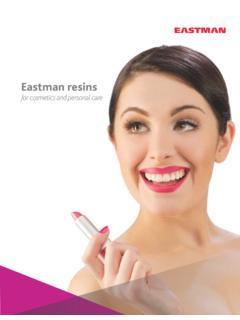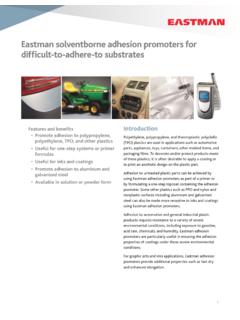Transcription of M-301A Selecting Effective Xylene Replacements …
1 1 AbstractThis publication is designed to assist formulators in replacing Xylene in traditional solventborne coatings. An aromatic hydrocarbon such as Xylene is more active than an aliphatic hydrocarbon and is a very important component in formulating protective coatings. Xylene is used extensively in many coatings systems as either the primary solvent or as a diluent. It is also commonly used in aerosols and as a synthesis solvent for acrylic resins and a reflux/letdown solvent for alkyd and saturated polyester were conducted on a series of paint formulations to determine whether combinations of an oxygenated solvent and aliphatic hydrocarbon could successfully be used to replace Xylene .
2 Three solvents (methyl amyl ketone [MAK], n-butyl propionate, and isobutyl isobutyrate [IBIB]) were shown to be Effective in replacing Xylene in traditional solventborne coatings. In the study, the three oxygenated solvents provided coatings with very low HAP content while maintaining coatings performance. At the same time, it was demonstrated that the oxygenated solvent could be blended with an aliphatic hydrocarbon to reduce cost without loss of coatings appearance or Effective Xylene Replacements for protective coatingsBackgroundTitle III of the Clean Air Act (CAA) of 1990 established a list of chemicals and chemical categories that are designated as hazardous air pollutants (HAPs).
3 Included on that list were several solvents that are commonly used in coatings facilities, , MEK, MIBK, toluene, and Xylene . The Environmental Protection Agency (EPA) has developed Maximum Achievable Control Technology (MACT) standards that establish HAP emission limits for 12 categories of industrial surface coatings pursuant to Section 112 of the options exist for reducing HAP emissions in surface-coatings operations. The three primary choices include (1) continue with existing coatings and invest in emission control equipment and technology; (2) select a different coatings technology such as water-based, powder, or UV-cure; or (3) reformulate present coatings using non-HAP coatings users believe that solvent reformulation (option 3) is the lowest cost alternative.
4 This choice is also based on other factors such as familiarity with current coatings, minimal equipment changes, and proven coatings performance. When this option is chosen, coatings suppliers must reformulate their coatings using non-HAP 1 shows three oxygenated solvents (MAK, IBIB, and n-butyl propionate) that are useful in formulating Xylene Replacements . Each solvent is supplied by Eastman and can be used to develop surface coatings with lower HAP content or essentially no HAPs. Each solvent is urethane grade (<500 ppm H2O) and is suitable for use in lacquers and thermoset and ambient-cured enamels.
5 2 Selecting Effective Xylene Replacements for protective coatings (Continued}Table 1 Physical properties for suggested Xylene replacementsPhysical propertiesXylenen-BuOPrMAKIBIBE vaporation rate (n-BuOAc = 1) gravity @ 20 /20 , ppm100 50 Max. incremental reactivity (MIR) resistance, megohms>20> >20 Solubility, water in, wt%< < , in water, wt%< < range, C135 146145 149147 153145 152 Flash point TCC, F8397c102104 Hansen solubility activity, cPR1 2-sec NC (8 wt%) (8 wt%)Insoluble11620 InsolubleParaloid B-66 (40 wt%)5208785802,450 Epon 1001F (50 wt%)Insoluble11782 InsolubleAcrylamac HS 232-2980 (70%)548538498668 Duramac HS 57-5720 (65%)778671581868 Polymac HS 57-5776 (65%))
6 157155123212a60 /60 FbReference Regulation for reducing the ozone formed from aerosol coating product emissions (subchapter )cSetaflashAcrylamac acrylic resin supplied at 80 wt% solids in MAK and reduced to 70 wt% solids with the given solvent. Duramac alkyd resin supplied at 75 wt% solids in 90/10 wt% MPK/n-butyl acetate blend and reduced to 65 wt% solids with the given solvent. Polymac polyester resin supplied at 85 wt% solids in PM acetate and reduced to 65 wt% solids with the given Effective Xylene Replacements for protective coatings (Continued}Developing Xylene replacement blends using non-HAP solventsThe choice of an alternative solvent or solvent blend can be greatly simplified by using computer software that allows the user to match or exceed the designated performance requirements.)
7 Particularly useful to the formulator is the ability to select solvents such that the solvent blend will dissolve the resin(s) used in the coatings formulation. This capability, which is predicting the miscibility characteristics of polymers and solvents, is possible through the use of solubility parameters. Once the solubility parameters have been established for a control blend containing Xylene , the software will provide a non-HAP solvent blend with similar values that will dissolve the resin(s) of choice for the selected critical to the success of the replacement blend is its evaporation rate characteristics.
8 The solvent blend of choice must provide the desired application and film formation properties. Again, computer software allows the user to match the evaporation rate profile of a control blend with that of a reformulated blend. This tool provides two very useful evaporation rate values. First, the value denotes the relative evaporation rate compared to n-butyl acetate = 1. Second, the program will provide information containing weight % solvent composition versus weight % of the blend evaporated. The composition of the solvent blend is shown at 10%, 30%, 50%, 70%, and 90% weight loss.
9 In addition, the solubility parameters for the blend are shown at each composition interval. The data allow the user to design a solvent replacement blend for a selected coating, which when applied to a surface ensures adequate flow and quality film a majority of coatings applications, the use of oxygenated solvents is required to satisfy the needs for a suitable non-HAP Xylene replacement blend. If the Xylene content is relatively low in the coating (<10% of the volatiles), a direct substitution with one of the solvents in Table 1 might be the most cost- Effective substitution.
10 However, for blends containing higher levels of Xylene , it may be desirable to examine combinations of oxygenated solvents with an aliphatic hydrocarbon to lower total formulating not shown in this study, alcohols such as n-butanol can also be used to develop alternatives to Xylene . The ratio of oxygenated solvent(s) to aliphatic hydrocarbon should be determined for each coating because resins vary in aliphatic hydrocarbon tolerance. Also, other solvents present in the blend can increase or decrease this effect. Again, the use of the solubility parameter concept is very valuable in estimating an appropriate range of aliphatic hydrocarbon level for a specific coatings an aliphatic hydrocarbon is used in the selected blend reformulation, one should choose a product with a very low HAP content.









